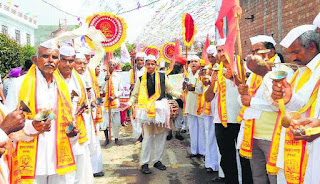India is divided into distinct linguistic regions. Leaders of every major linguistic region project their own language to be the lingua franca of India. There are instances in our history where group of people have clashed over linguistic skills creating acrimony in society. In this madness of one upmanship a ray of sunshine is"The Ghuman Bahubhasha Sahitya Sammelan", a multi-lingual literary festival organised at Ghuman town in the border district of Gurdaspur in Punjab on April 3 and 4.
Surprising it may sound, for organizing Marathi literary festival in Punjab but the reason behind it, is to commemorate the legacy of much revered saint Namdev, a legendary 13th-century reformist Marathi poet-saint Namdev from Maharashtra who lived in this village for nearly two decades. He was associated with the Bhakti Movement of that time. Locals embraced the saint as there own and incorporated 62 of the shabads(hyms) in sacred book of Sikhs, Guru Granth Sahib, as Namdevji ki Mukhbani.
A Gurudwara named after saint Namdev bears testimony to the fact that the social and spiritual bond between two diverse cultures is beyond rhetoric of symbolic secularism. Thousands of pilgrims throng to Ghuman Gurudwara Darbar Sahib Baba Namdev Ji for annual pilgrimage.
Marathi language and literature acted as catalyst to support and bringing together different languages of India as most other literature festivals are dominated by English and Hindi. The Ghuman literature festival has also stimulated translation of literary work between Marathi and Punjabi languages and hopefully into other languages in future to benefit readers. The theme of this year Ghuman literature festival was “renewal and restoration” of Urdu, Punjabi, Kashmiri, Bodo and Hindi languages.
Celebrating the connections between two languages and cultures is also a way to pay tribute to the saint tradition which is progressive and liberal and literature plays a positive role in uniting the society through emotional and intellectual content in it. The Ghuman festival is aimed at building bridges between Maharashtra and Punjab through literature which hopefully will grow with time and include and revive other local endangered languages of India .
Surprising it may sound, for organizing Marathi literary festival in Punjab but the reason behind it, is to commemorate the legacy of much revered saint Namdev, a legendary 13th-century reformist Marathi poet-saint Namdev from Maharashtra who lived in this village for nearly two decades. He was associated with the Bhakti Movement of that time. Locals embraced the saint as there own and incorporated 62 of the shabads(hyms) in sacred book of Sikhs, Guru Granth Sahib, as Namdevji ki Mukhbani.
A Gurudwara named after saint Namdev bears testimony to the fact that the social and spiritual bond between two diverse cultures is beyond rhetoric of symbolic secularism. Thousands of pilgrims throng to Ghuman Gurudwara Darbar Sahib Baba Namdev Ji for annual pilgrimage.
Marathi language and literature acted as catalyst to support and bringing together different languages of India as most other literature festivals are dominated by English and Hindi. The Ghuman literature festival has also stimulated translation of literary work between Marathi and Punjabi languages and hopefully into other languages in future to benefit readers. The theme of this year Ghuman literature festival was “renewal and restoration” of Urdu, Punjabi, Kashmiri, Bodo and Hindi languages.
Celebrating the connections between two languages and cultures is also a way to pay tribute to the saint tradition which is progressive and liberal and literature plays a positive role in uniting the society through emotional and intellectual content in it. The Ghuman festival is aimed at building bridges between Maharashtra and Punjab through literature which hopefully will grow with time and include and revive other local endangered languages of India .





No comments:
Post a Comment